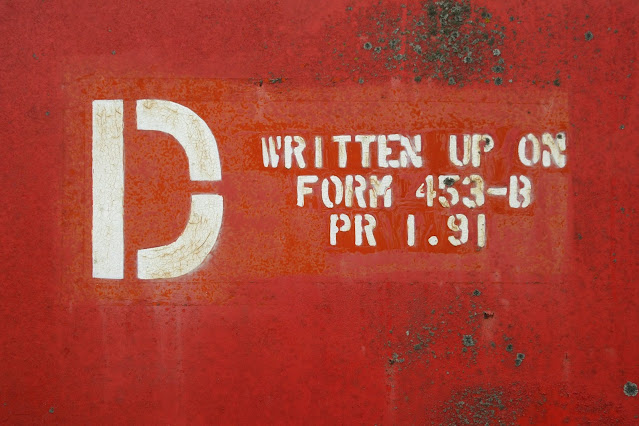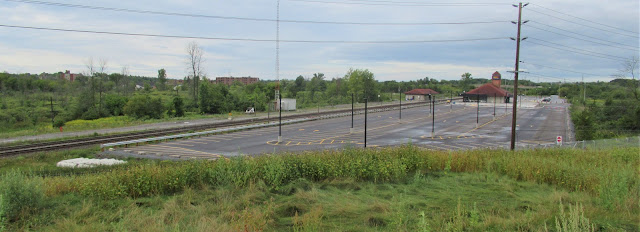EVERYTHING OLD IS NEW AGAIN - THEN IT GETS RECLAIMED
Scrap that! Rolling stock was re-purposed until it either wore out or could no longer be re-used and was only fit for scrapping. Commonly, revenue equipment became work equipment. CN had reclamation yards at Transcona (Winnipeg), London ON, Moncton NB, Pointe St. Charles (Montreal), Battle Creek, MI and St. Albans, VT. Long-term storage yards were maintained at Southwark south of Montreal; Stratford, Scarboro and Paris West in Ontario. CN got into the reclamation business in earnest in 1928.
In this post, I look into CN's reclamation operations, specifically the London Reclamation Yard. The place has long fascinated me - a railway's dinosaur boneyard. Prolific bloggers of the White River Division, George Dutka and Peter Mumby, have only whetted my appetite for more scrap. Since I have no photos to share, having only been to London briefly once on CN, check out the links at the end of this post for George and Peter's excellent coverage of the London site over time.
TRANSCONA - 1951
CN Vice-President, Western Region J.R. McMillan initiated a drive to collect iron and steel scrap. The Transcona reclamation yard covered 50 acres. It was the collecting point for all scrap from British Columbia, Alberta, Saskatchewan, Manitoba and North-western Ontario. Iin 1951, over 50,000 tons of scrap came in, at a rate of 150 tons per day: rolling stock, locomotives, work equipment, rail, draft gear and even pot-bellied stoves. Most of the outgoing scrap went to furnaces at Sault Ste. Marie, Montreal, Hamilton, as well as Selkirk, St. Boniface and Flin Flon, in Manitoba.
LONDON - 1957
The London Reclamation Yard earned CN over $5,000,000 in recovered scrap in 1957. System-wide, scrapped 2,664 cars and 207 locomotives were reclaimed that year. The 106 workers at the London yard were divided into two groups: burners and labourers. Burners were the acetylene cutting-torch operators, and labourers assisted and sorted the resulting scrap. The yard had two cranes, one equipped with a 52-inch electro-magnet that could lift 30 tons. The yard classified 21 types of ferrous metals (those containing some form of iron) and 13 types of non-ferrous metals. Wooden cars were still being burned at this time, before cooling off and cutting up took place.
As diesel power replaced steam, the CN steam fleet was sidelined, stacks capped, rods removed to running boards, appurtenances removed and coupled in long lines awaiting scrapping. Steam engines took 5-6 days for scrapping, requiring both cranes and four men.
LONDON RECLAMATION YARD(s) - HISTORY
There were actually two reclamation yards in London at different times. The first dated back to 1880, as a car shop scrap yard adjacent to the GTW/GTR/CN car shops on Egerton Street, extending along Brydges Street to Ashland Avenue between CN's Dundas and Thorndale Subdivisions. Reclamation operations were phased out here by 1960.
The 'Sand Pit' became the reclamation yard in the 1950's. Located east of the CN's main yard and east of Hale Street at Trafalgar Street south of the double-track Dundas Sub, the stub-ended yard tracks extended east to an embankment overlooking Potter's Creek ravine. The Fairmont subdivision was developed there in the 1950's and 1960's, and some of its houses overlooked the yard's north side. 'Burning' operations were transferred to Paris West, while wood and metal reclamation operations stayed. There was increased security at the sight due to the ongoing problem of pilferage.
London East yard became a virtual rolling stock museum. Cars for scrapping were moved to the south tracks there prior to scrapping, with their air lines cut to prevent use. Such cars received the D-453 classification by stencil or spray paint, meaning pending Destruction - Form 453 filled out (top photo).
The London reclamation yard was phased out circa 1991, though the local Engingeering forces still use the site for material storage. Some scrapping for CN is still carried out at John Zubick & Sons nearby. Zubick is rail-served and, interestingly, the scrapyard contains well over 100 surplus Canadian Forces armoured patrol vehicles.
- C-Liners in 1967 and 1968.
- More November 30, 1968 photos by Robert Farkas and three CN cabooses.
- White River Division (WRD) part one by Peter Lumby.
- WRD posts then and now, part two and part three plus part four and part five.
- JW Booth photos of switchers to be scrapped.
- At Dundas: funeral train of steam locomotives for scrapping.




3 comments:
Hi Eric:
Nice article on the rec yard. My father in law told me about the old reclamation yard off the Thorndale sub...not exactly sure were but close to Egerton St. I still have more photos and stories about the Hale St facilities to share at some point...cheers...George Dutka
No pressure on the Hale St facility, George! You know better than anyone my near-obsession with this scrap operation! Thanks for the inspiration. I really feel your WRD posts cover it so well, I wanted to record the information I had from Don McQueen and centralize it all for my own reference. Just like all the posts here on Trackside Treasure.
Thanks for your comment,
Eric
Thanks for the shout-out! Quality, not quantity, indeed!
Post a Comment